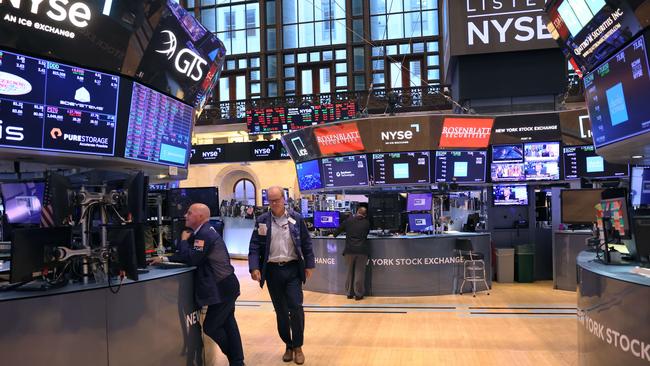Faster US interest rate hikes to hit Australian dollar as Federal Reserve moves again
The Federal Reserve, led by Jerome Powell, has delivered a harsh reality check on the US inflation battle, and Australia will also feel the pain.
The Federal Reserve’s harsh reality check on the US inflation battle should finally convince perennial bulls to stop fighting the world’s most powerful central bank and accept that financial conditions need to remain tight for some time.
Interestingly, the US sharemarket closed down after the decision. It was the first time this cycle that it fell on the day of a rate hike.
After a brief post-meeting rebound, the S&P 500 closed down 1.7 per cent at a two-month low of 3789.5 points.
For Australia, it means the RBA will be pressured into lifting interest rates more than it wants to, risking a recession which may include some of the sharpest falls in house prices on record.
Australian dollar weakness is the mechanism by which aggressive US interest rate hikes will be transferred to Australian interest rates, as it puts upward pressure on the price of imported goods.
The Aussie has dropped 1.3 per cent to a two-year low of US65.83c since the Fed delivered a widely expected 75 basis point lift in the Fed funds rate, and more importantly, a “dot plot” projecting sharply higher and more enduring US interest rate increases than the market expected.
While the RBA persists with rhetoric about seeking to return inflation to its 2-3 per cent target band while “keeping the economy on an even keel”, a perception of narrowing interest rate differentials, and a risk of a sustained outbreak of inflation that requires the equivalent of monetary policy “shock treatment” at a later date – causing deep recession – will tend to pressure the Aussie.

Under pressure from an independent review of its policymaking, the RBA will probably keep giving such a mixed message (relative to the Fed) for some time, as Australia’s wages growth hasn’t officially taken off despite warning signs in NAB’s business survey.
That’s particularly so if the RBA slows the pace of rate hikes to 25 basis points next month.
But after the relatively “hawkish” outcome of the Fed meeting this week, the RBA won’t see an “opportunity” to “taper” the pace of rate hikes at its October board meeting.
With the Fed’s dot plot implying another 75 basis point rate hike at its November meeting and 50 basis point in December – December is probably the earliest that the RBA will see an opportunity to taper – barring surprisingly-low CPI or surprisingly high unemployment data.
On the charts, the Aussie dollar looks to be forming a “Descending Wedge” pattern which could guide it down towards US60c, dragging down the more important trade-weighted index.
Domestic markets are closed for a public holiday on Thursday.
But government bonds and equities in particular, face falls when trading resumes Friday.
Overnight S&P/ASX 200 index futures fell just 0.8 per cent on Wednesday.
However, S&P 500 futures were down about 0.7 per cent in Asia-Pacific trading, suggesting another rough day ahead for Wall Street on Thursday.

BetaShares chief economist David Bassanese noted that while bond markets have long priced in aggressive Fed rate hikes, they have continued to rise as the extent of expected rate hikes has continued to be revised up.
After the FOMC meeting, the US 2-year yield topped 4 per cent for the first time in 15 years.
The benchmark 10-year yield jumped to 3.62 per cent and looked to find a base at 3.5 per cent.
“US bond yields will only peak once we have reached peak pessimism in terms of expected future rate hikes, Bassanese said.
“There is a risk the Fed and market eventually price in a peak Fed funds rate over 5 per cent, suggesting there is a risk that US 10-year bond yields could rise further – potentially reaching over 4 per cent by year-end.”
That will wreak havoc on stock valuations.
He said equity markets also “remain vulnerable” given that even the mild recessions anticipated by the Fed does not appear priced into the market.
But current market expectations still imply almost 10 per cent growth in earnings per share among S&P 500 listed US companies next year – which seems unrealistic if a recession is coming.
And at 16.5 times forward earnings, the S&P 500 is “nowhere near the type of valuations seen during recession lows of usually around 10 to 14 times.”
Back-solving for implied S&P 500 levels – assuming that somewhat unrealistic 10 per cent EPS growth is achieved (perhaps by share buybacks) implies 3216 points at the high point of Bassanese’s “recession valuation” range, 2764 points at the midpoint, and 2297 points at the low point.
That implies falls of 15 per cent, 27 per cent or 39 per cent from current levels, which would put the S&P 500 down between 33 and 53 per cent from the bull market high versus 21 per cent now – which sounds realistic.







To join the conversation, please log in. Don't have an account? Register
Join the conversation, you are commenting as Logout